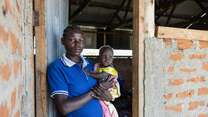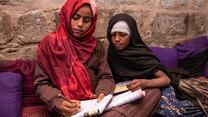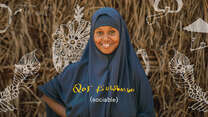WHO WE ARE
The mission of the International Rescue Committee (IRC) is to help people whose lives and livelihoods are shattered by conflict and disaster to survive, recover and gain control of their future. Our vision is that the IRC will lead the humanitarian field by implementing high-impact, cost-effective programs for people affected by crisis, and shape global policy and practice by sharing our learning and experience with others.
All our programs are designed to improve people’s health, safety, education, economic wellbeing and ability to positively influence the decisions that affect their lives. The IRC recognizes that with support and investment, adolescent girls can transform their lives and their communities. Working with girls instead of on behalf of girls, the IRC’s programs are driven and led by girls in a way that empowers them long into the future.
WHY OUR WORK MATTERS
It is estimated that 120 million girls under the age of eighteen have experienced rape or other forms of sexual violence.
Adolescent girls are among the most marginalized populations in the world, and many are vulnerable to multiple forms of violence. During adolescence, while boys’ worlds expand, girls’ worlds start to shrink. Harmful gender norms perpetuate beliefs that girls have less value and are less capable than boys, resulting in the denial of education, social isolation and exploitation. Moreover, girls’ expected positions in households and communities mean they engage in heavy labor, leaving little time to access basic necessities such as health care and even food.
While support for the needs of adolescent girls is growing, less focus has been paid to adolescent girls living in emergency settings. Conflict and disaster greatly increase a girl’s exposure to exploitation and abuse and reduce her chances of reaching her full potential. For example, recent research conducted by the IRC found that 40% of girls in the Democratic Republic of Congo and Ethiopia reported experiencing sexual violence.
Communities and families often respond to conflict by increasing harmful traditional practices, such as early and forced marriage, as a perceived means of protection for their daughters. Girls’ assets, their labor, time and safety, are also sacrificed to provide for the needs of others in the family, often forcing them to trade sex for goods or money in order to survive. These realities continue to stretch girls’ existing coping capacities and remove them further from critical opportunities that contribute to their future well-being. For too many girls, an emergency starts as a single “event” and transforms into a lifetime of adversity. The health, education and social behaviors established during this pivotal adolescent life stage have long-term negative or positive impacts.
- A 12-year-old girl in Nigeria is forced to drop out of her first year of school for fear of attacks from Boko Haram.
- A 10-year-old from Syria escapes the war and leaves her dreams of becoming a doctor behind in the destruction of her home town.
- A family forces a 13-year-old Somali girl living in the world’s largest refugee camp to marry a 40-year-old man as a way to increase her “protection” and secure the honor of the family.
- A 15-year-old girl in Pakistan living in an internally displaced person’s camp is sexually assaulted by an uncle and discovers she is pregnant.
When a girl in the developing world receives seven years of education she marries four years later and has 2.2 fewer children. If she is able to decide when to marry and have children, she and her children are more likely to lead healthier, productive lives and exit the cycle of poverty. One additional year of primary education increases a girl’s eventual income by 10 to 20%.
Girls facing the crisis of an emergency can fall further, but with critical support and resources, they can fly higher.
WHAT WE DO
IRC practitioners provide technical assistance to more than 30 country programs. Technical advisors are charged with staying abreast of the best available research and practices in their respective fields and sharing these with the IRC’s frontline teams. They also lead advocacy strategies to encourage partners and policy makers to adopt the interventions proven to be effective based on our research and experience.
During adolescence, interventions aimed at preventing and responding to violence against women and children intersect. This is especially true for older adolescent girls who may be treated as women by their families and communities but are still in a developmental life stage where they are also children. This is a key intersection where both age and gender must be considered. Multi-sectoral, age-appropriate and girl-driven programs and services in humanitarian settings are crucial to protect girls from violence and empower them as independent, healthy and productive individuals who are respected and valued by their families and communities.
The IRC’s work with adolescent girls brings to bear both a gender and an age lens. As a result, IRC programs are able to holistically focus on addressing the root causes of violence, increasing opportunities for girls, and providing high quality services and support to those who have experienced violence. We engage girls, their parents and caregivers, and community leaders to combat harmful norms and practices such as early and forced marriage, female genital mutilation (FGM), and denial of education. Our intervention models are based on extensive research and years of experience, and include the following programs:
COMPASS—Creating opportunities through mentoring, parental involvement and safe spaces: COMPASS is a 3-year pilot program designed by the IRC to respond to the vulnerabilities of adolescent girls in humanitarian crises by establishing a foundation for their healthy transition into adulthood. This includes providing safe spaces for girls for life-skills training and asset building; training mentors and mentoring activities with the support of older adolescent girls; discussing gender inequality, gender- based violence and positive parenting with parents and caregivers; and engaging service providers and caregivers to better prioritize and meet the needs of adolescent girls.
Funded by the UK Government’s Department for International Development (DfID), COMPASS is being implemented in Pakistan, Ethiopia, and the DRC. 2,475 girls and 1,442 caregivers have completed the program cycle across all three countries to date.
In addition to the program activities, COMPASS includes a research component to understand the feasibility, acceptability and effectiveness of the COMPASS curriculum for adolescent girls in humanitarian settings and includes two cluster-randomized controlled trials in refugee camps in Ethiopia and in conflict- affected communities in eastern DRC, and a mixed-methods design in Khyber Pakhtunkwah province, Pakistan. Research results will be available in 2017.
GIRL EMPOWER—Empowerment of adolescent girls and young women: GIRL EMPOWER is an innovative IRC program with a holistic approach that addresses key aspects of girls’ lives, including their social capital, access to education, financial literacy, role models and the attitudes of family members. Through GIRL EMPOWER, girls develop and attain financial goals, increase self-confidence, become self-reliant, develop a system of support in their community and are supported in a safe and healthy environment.
With support from the Novo Foundation, the IRC has implemented the Girl Empower model in Liberia and Ethiopia, reaching over 2,000 girls who face high risk of early marriage and FGM. The program is currently being evaluated to assess the impact of Girl Empower alone, and Girl Empower combined with a conditional cash relief program. This research will add to the existing knowledge base of interventions for girls in humanitarian settings.
Imagining Our Futures —Girls envision a future for themselves: Through this program, adolescent girls have the opportunity to explore their aspirations, design their own visions for their future, and challenge social norms. Girls use photography and other creative media to illustrate their visions and build the skills they will need to achieve their goals. The program engages parents, local leaders and communities in order to shift harmful attitudes about girls, and in turn create community solutions to combat violence against women and girls and gender inequality.
Girl Shine—Developing best practice new programming: Girl Shine, IRC’s signature adolescent girl intervention, works to build resilience, protection and empowerment for girls ages 10 to 19 years, specifically in humanitarian settings. It is based on the evidence generated from all of the IRC’s work with adolescent girls. It directly addresses the primary barriers to development and education in humanitarian settings, including violence, isolation, early marriage and other harmful traditional practices. Core Girl Shine elements include girl-only safe spaces and support groups, a mentor-led life skills program, and a parent and caregiver support group.
The life skills program employs a creative approach by offering a variety of methods to engage girls including art, improvisation, games, writing and self-reflection. Most importantly, the content is girl designed and driven, so it best reflects the day- to-day realities girls face in multiple humanitarian contexts. The IRC will officially launch the Girl Shine program model and toolkit in 2017.


